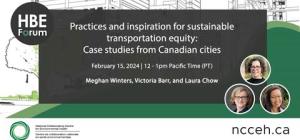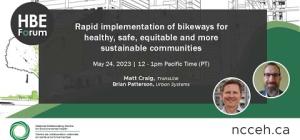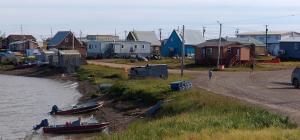
Community-based adaptation approaches to sea level rise and health

Photo credit: Ville de Belle-Baie, New Brunswick. Credit Pascal Chiasson (2020), with permission
This report is part 3 of 4 from the NCCEH/CLIMAtlantic “Sea level rise and public health implications” project. Please see the full project description and companion reports here.
Key Messages |
|
Introduction
Sea levels are rising in Canada due to three factors: 1) meltwater volume added from glaciers, polar ice caps, and ice sheets; 2) thermal expansion of warming ocean waters; and 3) land subsidence of some areas within Canada following the last ice age.1 As sea level rise intensifies coastal hazards and exacerbates coastal flooding and erosion events, the coastal communities most exposed to these hazards are at risk of experiencing impacts to health. Possible direct and indirect risks to human health include increased exposure to waterborne diseases, vector-borne diseases, other harmful substances, reduced air quality, and compromised social determinants of health such as livelihood and food security, which can affect both mental and physical health and well-being.
Climate change adaptation plans (CCAPs) are tools used by municipalities across Canada to enable communities to identify the hazards, risks, and opportunities posed by climate change. These and other local studies and planning documents can be used to determine a community’s vulnerabilities (for example, to sea level rise), and the impacts of those vulnerabilities on health. Adaptation plans identify actions that can help communities become resilient to the impacts arising from climate change.
As detailed in Report #1 of this series Overview of Canadian communities exposed to sea level rise, the regions of Canada projected to be most exposed to rising seas include the Atlantic coast, the mainland coast of the Beaufort Sea, the cities of Metro Vancouver and southern Vancouver Island, as well as the many Indigenous communities situated along these vulnerable coastlines. Report #2 summarized the Health risks associated with sea level rise faced by communities. The purpose of this third report is to review community-level planning approaches and determine if, and how, public health considerations for sea level rise have been incorporated into adaptation planning. The analysis summarizes current practice and lays the groundwork for practitioners working in public health, climate change, or land use planning, to consider how to better incorporate public health considerations into community planning initiatives.
Methodology
Documents for this review were compiled from publicly available climate change adaptation or action plans, provincial Climate Action Plans, other climate vulnerability studies, and local land use plans for a selection of communities in coastal regions most exposed to sea level rise in Canada. Documents were found online or were shared through local or provincial contacts. A total of 131 reports, adaptation plans, vulnerability studies, and land use plans were identified from 58 coastal communities, of which 37 were in Atlantic Canada, four in the Northwest Territories, and 17 in British Columbia. Table 1(a-c) identifies these communities alongside the sea level rise exposure maps from Report #1 for each region. Communities within these geographic areas without land use plans or CCAPs were not included in the scan. While not generally considered to be part of Atlantic Canada, les Îles-de-la-Madeleine (QU) was included in this review given its physical location in the Gulf of St. Lawrence and its extreme exposure to sea level rise. This report does not provide a detailed review of all documents, but is a content scan of CCAPs and land use plans, and is the first such scan of Canadian communities’ treatment of health impacts of sea level rise in adaptation planning.
There are various terms used to describe the documents reviewed; therefore, going forward, general terms will be used to describe these as detailed in Box 1. Importantly, CCAPs result in climate-focused recommendations for local governments to consider. Land use plans are regulations or by-laws that require land use to take place in a particular manner, and are often seen as one of the key steps in implementing coastal adaptation measures.
|
Box 1: Document types |
|
A wide range of documents were reviewed during the course of this research, many of which contain similar content but use various titles. For the purpose of this report, the following general terms will be used:
|
Approximately 25% of communities identified in Table 1(a-c) did not have a CCAP, or did not have one that was available for public review. The remaining communities had at least one climate change-related document available, and some had multiple documents, especially larger urban communities. The climate-change related documents were published from as early as 2008 to December 2022, with most published after 2017. In Nova Scotia and the North, documents were dated 2008–2014. Existing land use plans for most communities were older, with the majority adopted between 1996 and 2015. Generally, First Nation communities were less likely to have land use plans, but equally likely to have climate adaptation plans or studies compared to municipal entities.
Documents were scanned for references to “health” and “sea level” as well as other climate hazards that are influenced by sea level rise (e.g., coastal flooding) and could impact on health. Based on the findings in Report #2, documents were also reviewed for content related to salt-water intrusion, infrastructure at risk (specifically in relation to sewer and water), displacement, mental health, vector-borne diseases, food security, transportation issues (related to access to health services or food sources), and social determinants of health. In addition, climate change adaptation strategies and guiding documents from the subject provinces and the Northwest Territories were also reviewed for content linking sea level rise and health. A full list of documents reviewed is available upon request.
Table 1a. Jurisdictions for document review (East Coast)
| Atlantic Canada | |
A. Acadian Peninsula and Chaleur (NB)
|
B. Northumberland Strait
|
C. Chignecto Isthmus
|
D. Atlantic Coast (NS)
|
E. Gulf of St. Lawrence
|
F. Newfoundland coasts
|

Table 1b. Jurisdictions for document review (West Coast)
| British Columbia | |
A. Metro Vancouver Area
|
B. Sea to Sky:
|
C. Southern Vancouver Island
|
D. Haida Gwaii
|

Table 1c. Jurisdiction for document review (North)
| Northwest Territories | |
Beaufort Sea
|
|

Findings
Consideration of health impacts of sea level rise in provincial and territorial climate action plans
In Canada, provincial governments establish policy, action plans, and regulations to support municipal responses to climate change and land use. In 2022, provincial climate action plans were renewed in Prince Edward Island,2 New Brunswick,3 Nova Scotia,4 and British Columbia.5 Newfoundland and Labrador’s plan is scheduled for renewal in 2024,6 and the Government of the Northwest Territories’ Climate Change Strategic Framework was published in 2019.7 The review of provincial and territorial level plans and studies found that flooding and sea level rise are recurring themes, whereas health is referenced in general terms unrelated to sea level rise.
Inclusion of sea level rise in provincial and territorial climate plans
In the documents reviewed, all coastal provinces and the Northwest Territories identified sea level rise as a key hazard of climate change, primarily as a threat to coastal infrastructure such as transportation routes, water and wastewater pipes, wastewater treatment plants, and lagoons. In the Atlantic Provinces, where a large proportion of coastal regions have no water and wastewater services, sea level rise is predicted to threaten groundwater quality, potentially causing salinization and contamination of wells. While no direct connections are made between water and health, the challenges with water quality and wastewater treatment are inherently linked to public health and safety.
Plans from PEI, Nova Scotia, Northwest Territories, and British Columbia recognize that sea level rise may also lead to losses of areas of historical, cultural, and archaeological significance, as well as impacting traditional food harvesting practices for Indigenous populations.
Inclusion of health considerations in provincial and territorial climate plans
Most provincial and territorial climate plans, which are regularly updated (usually every five years), include concepts related to health, but usually not in relation to sea level rise. Prince Edward Island’s climate action plan focuses its health concerns on extreme heat, food security, mental health impacts of climate change in general, and the disruption or loss of access to health services during an extreme event (e.g., flooding).2 In Nova Scotia’s climate change and well-being report, health is considered extensively with a particular focus on vulnerable populations.4 Specifically, it recognizes that reductions in mental and physical well-being may occur because of more exposure to extreme conditions such as heatwaves, floods, and storms.
“These events coupled with gradual changes in climate may alter food and water security, reduce air quality, increase exposure to contaminants and diseases, limit engagement in cultural, spiritual, ceremonial and subsistence practices, and reduce access to health resources via damage to critical infrastructure.” 4
Further, the report suggests that the impacts of climate change will be worse for people with underlying health conditions and those who already face barriers to affordable housing, food and water security, healthcare, and emergency response services. New Brunswick’s renewed Climate Action Plan does not mention health, except in terms of recommending public health officials be included in local adaptation planning activities;3 however, the Province’s involvement in the national HealthADAPT program established baseline data for health impacts arising from a range of climate change effects.8 Newfoundland and Labrador’s current action plan seeks to integrate climate change considerations into provincial health initiatives.6 The Northwest Territories’ climate strategy has many references to health, as well as food security and access to traditional foods.7 It is currently working on a territorial climate risk assessment that includes sea level rise. British Columbia’s Climate Preparedness and Adaptation Strategy establishes health and well-being as one of six key principles that guided the development of the strategy. Specifically, this strategy seeks to invest in healthier, sustainable, and more resilient communities and proactively considers climate impacts in decisions related to the design and construction of infrastructure.5
Health impacts from climate change were not addressed consistently across the documents reviewed. Health was rarely considered in some documents, while in others there was full integration of public health and vulnerability concepts. However, none of these provincial or territorial jurisdictions explicitly link sea level rise to health outcomes or establish actions to reduce potential health impacts directly from sea level rise. The provincial-level strategies recognize public health as a priority and tend to focus on climate actions that may indirectly impact the public in terms of infrastructure or creating a healthy built environment. Indeed, national level experts concede that exposure to sea level rise has not been substantively addressed in much of the guidance for provincial, territorial, or local governments on the health impacts of climate change, as confirmed by the document scan.[1]
Consideration of health impacts of sea level rise in community-level planning approaches
Local governments do not use climate change adaptation planning uniformly across coastal regions of Canada. There is significant uptake in provinces where CCAPs are either mandatory or provincially funded. For example, in 2012, it became mandatory for municipalities in Nova Scotia to develop municipal climate change action plans to be eligible to receive provincial gas tax funding. As a result, all municipalities in Nova Scotia adopted these plans by 2014. In New Brunswick, the Environmental Trust Fund provides funding to develop community-based assessment of coastal vulnerability. In these two provinces, the majority of communities now have some type of CCAP. In Newfoundland and Labrador and Prince Edward Island, no similar guidance or support is provided. This, combined with limited capacity in the many small communities, means that there are few local CCAPs in these provinces, a similar situation to the Northwest Territories. Infrastructure funding and proposed changes in British Columbia’s emergency management legislation will soon require climate change risk assessments to be considered by local authorities.9
Inclusion of sea level rise in the document review for communities
In the review of documents communities located in the most exposed regions, sea level rise is often identified as a threat or discussed in relation to adaptation measures. Most communities recognized sea level rise as either a climate hazard, or driver of climate hazards like coastal flooding and erosion. Many communities included future projections and mapping to aid in decision-making, particularly in relation to infrastructure. Half of the communities reviewed did identify various strategies for adapting to sea level rise. This included measures to reduce impacts of flooding, such as floodproofing existing buildings, installing structural protection measures (e.g., coastal armouring), and implementing land use rules to regulate development along the coast. Communities rarely identified cultural impacts of sea level rise. Only two communities linked possible impacts on drinking water safety from salt water intrusion to sea level rise. Twelve percent of communities in exposed areas did not identify sea level rise in their documents, with no CCAPs completed and documents comprising outdated land use plans.
Inclusion of health considerations in the document review for communities
Sixteen communities did not reference health or health-related issues in any of their documents. Public health concerns in relation to climate change, including those linked to sea level rise, ranged from brief references to extensive discussion. For example, several communities recognized the potential loss of access to emergency services, including health services or transportation corridors, during a flood event. The potential contamination of water or land with wastewater due to infrastructure damage or flood water inundation was noted as a potential health concern in about 25% of communities. Many coastal communities identified the impact of climate change on the social determinants of health, including food security due to salinization of coastal agricultural lands, and the change in habitat of marine and coastal food sources. In Atlantic Canada, potential salt water contamination of drinking water was noted by several communities. Less frequently, mental health impacts in relation to extreme weather events, threat of contaminants impacting water quality, and mould in homes following flood events were noted.
One notable CCAP in New Brunswick draws a direct connection between sea level rise and potential health implications. Box 2 highlights this document, followed by an example from Nova Scotia of how health impacts from coastal flooding, which can be exacerbated by sea level rise, are considered in eastern Canadian communities.
[1] Personal communication. Anon, Government of Canada 2022, Sep 14.
|
Box 2: East Coast examples of sea level rise and health considerations in CCAPs |
|
Climate Change Adaptation Plan: Chaleur Region (2019)10 The CCAP from the Chaleur Region of New Brunswick is the only community-based document in Atlantic Canada that specifically links sea level rise with health outcomes. It identifies sea level rise as a community vulnerability along the coast, which could cause increased risks of flooding, erosion, storm surges, coastal wetland destruction, and salt water intrusion. The systematic assessment examines sea level rise impacts and possible consequences for health and safety, displacement, loss of livelihood, and social health, among other impacts. Vulnerability mapping identifies key areas of the communities most at risk from these impacts. Community workshops have further identified primary concerns of residents while also uncovering a lack of understanding of potential health impacts. The CCAP proposes various adaptation actions, such as infrastructure relocation, sea wall armouring, and community education. |
|
Municipality of the District of Chester CCAP (2013)11 This early CCAP from Nova Scotia recognizes that health and safety can be impacted by coastal flooding and related sea level rise. While it does not make a specific link to health impacts of sea level rise, it does recognize that:
|
Consideration of community-level adaptation measures for addressing the health impacts of sea level rise
Sea level rise and its potential direct impacts on communities, and indirectly on public health, was a driver for many adaptation measures. The most frequently recommended actions in community-based planning approaches to climate change adaptation, in order of the frequency they appeared, include:
- Conduct studies of and/or invest in infrastructure in local communities. Specific actions included investing in forms of green infrastructure to reduce the impacts of sea level rise on the community as it is noted to have many co-benefits for environmental and human healt12
- Share information and build capacity of municipal staff and/or the general public regarding sea level rise and its impacts on the community.
- Partner with public health to create adaptation measures that better address the health impacts of climate change in general.
- Advocate for structural changes for buildings at risk such as floodproofing and installation of backflow valves.
- Plan for emergency measures relating to extreme events like flooding, particularly to ensure that transportation access to and from affected areas of the community is maintained or restored as quickly as possible.
- Establish land use planning provisions to prevent building in hazard areas and/or focus on creating a healthy built environment in the community.
- Collect more data (e.g., the number of private wells, water quality in those wells, local tide ranges) and create maps to identify the most exposed land areas.
- Consider managed retreat from hazardous coastal areas as an option.
Adaptation measures specific to flooding, and often sea level rise, tend to focus on four types of physical adaptation strategies: protection, accommodation, retreat, and avoidance.13 Protection measures generally involve building barriers between the land and water, be it coastal armouring or construction of grassed berms, dykes, or engineered seawalls. Accommodation measures include options such as salt marshes that allow water to flow further inland as needed. Retreat measures often result in the physical relocation of buildings, assets or even communities, away from the coastal hazard. Finally, avoidance measures are preventive measures, such as land use regulations that restrict development in coastal hazard areas to reduce the number of built assets affected during flood events. CCAPs often suggest implementation of a combination of the above approaches depending on the context of each situation.
Whatever combination of approaches a community determines to be appropriate, it is important to consider the full extent of health impacts that may result from these strategies. As noted in Report #2 of this series, rapid displacement due to a single event (e.g., coastal flooding), or managed retreat in response to gradual change or repeated exposure to events, can result in a range of impacts on mental health. Social determinants of health can also be compromised, such as food or water security, secure housing, or livelihoods, which can compound some of these mental health impacts, or introduce new physical health impacts. Box 3 highlights two examples of good practices for developing adaptation measures for sea level rise that have a positive impact on health.
|
Box 3: West Coast adaptation practices |
|
Fraser River Coastal Adaptation Plan (2018)14
To ensure that rising sea levels are accommodated in long-term planning, this document advocates to design future development that is adaptable and resilient to projected hazards like flooding and storm surge. This resilient development approach also has co-benefits that support multiple community values, such as the creation of more recreation space, which can improve health and well-being and foster stronger personal connections within communities. The plan also advocates development design that protects safety and public health and minimizes risk to community members. Where public health is at higher risk in vulnerable communities and relocation of existing homes or infrastructure is not feasible, the plan advocates a multi-tiered approach combining, for example, protective dykes, floodproofing buildings, emergency warning systems, and public education. Further, the plan seeks to apply flood management approaches on brownfield sites to minimize risk of water contamination if, and when, the land is inundated. Long-term, others goals include removing soil contaminants from flood zones and relocating homes where possible.
|
|
City of North Vancouver Official Community Plan (2014)15
This land use plan begins with emphasizing the importance of working with neighbouring municipalities and community partners in creation of plan policies that shape the community into the future. Health is a primary focus throughout the document and a formal Memorandum of Understanding was created with Vancouver Coastal Health to ensure the link between health and the built environment was made in policies throughout the document. While not specifically focusing on sea level rise and health, the use of a climate and health lens in developing land use policy is a best practice in community-based planning approaches, which can result in co-benefits for people and the natural environment. |
Consideration of the health impacts of sea level rise in planning for climate change in Indigenous communities
Report #1 of this series identified a selection of 15 Indigenous coastal communities as highly vulnerable to sea level rise and the associated health impacts, including four communities in the Northwest Territories. The majority of Indigenous communities studied do not have land use plans. One reason may be that land use planning is regulated by the province for municipalities, and First Nation reserve lands fall outside of this legislative regime. Another reason may be that conventional land use planning approaches do not fit within traditional world views of Indigenous land management. Land use documents such as zoning by-laws were publicly available in some communities in Northwest Territories, but are generally focused on development provisions and not land use planning policy for the communities. CCAPs, on the other hand, have been undertaken by the majority of these communities but may not be publicly available.
All documents reviewed from selected Indigenous communities in Atlantic Canada identified sea level rise as a concern in relation to flooding and erosion, including the physical loss of land to the sea. Sea level rise projections and mapping are common approaches to assessing vulnerability in Nova Scotia, New Brunswick, and for Lennox Island in Prince Edward Island. Sea level rise was less of a concern for communities in the North, with permafrost melt being a much higher priority. In British Columbia, most Indigenous CCAPs considered flooding and vulnerability of the communities, but in relation to general climate hazards and not necessarily sea level rise. Infrastructure vulnerability was a concern in virtually all coastal Indigenous communities, including roads, underground water and sewer pipes, and housing. In addition, several communities identified the loss of archaeological, cultural, and ceremonial sites of significance as an important issue. Food security and impacts of climate change and sea level rise on the traditional food harvest was one of the most significant concerns identified.
The review of 26 documents and websites for the 15 identified Indigenous communities found many references to health and health-related concerns about climate change impacts such as flooding. Specifically, CCAPs identified the following:
- Saltwater intrusion into drinking water systems during flood events is a major concern (Ugpi’ganjig,16 L'nui Menikuk, Pictou Landing,17 Lennox Island First Nations,18 Haida Gwaii region19).
- The release of contaminants from wastewater treatment systems (inundated lagoons and broken pipes) during flood events is possible (Tsleil-Waututh,20 Ugpi’ganjig,16 Lennox Island,18 and Pictou Landing17 First Nations, Tuktoyaktuk21).
- Socio-cultural health is impacted by sea level rise with loss of access to the beach and archaeological and ceremonial sites (Tsleil-Waututh,20 Pictou Landing,22 Potlotek,23 and Lennox Island First Nations24).
- Location of medicinal plants and shellfish harvesting are at risk from sea level rise (Tsleil-Waututh20 and Ugpi’ganjig16 First Nations).
- Food security and traditional harvest is at risk, resulting in increased dependence on store-bought processed foods, leading to health issues such as obesity and diabetes (Tuktoyaktuk,21 Ulukhaktok25).
- Loss of access (inundated roads) for emergency services to and from reserves or community locations is a concern (Pictou Landing,22 Tsleil-Waututh,20 and Tsawwassen26 First Nations, Tuktoyaktuk,21 Ulukhaktok,25 and the Haida Gwaii region19).
- For the Haida Gwaii communities, sea level rise and wind, waves, and storms will have the greatest direct impacts. Indirectly, changes in the ecosystems, fisheries, and aquaculture will result in negative social and economic impacts due to the high dependence on resource-based life.19
Adaptation actions in Indigenous coastal communities to reduce the long-term health impacts from sea level rise and associated issues of coastal erosion and flooding included:
- Considering managed retreat of houses as well as key infrastructure such as sewage lagoons, waste dumps, and cemeteries (Potlotek First Nation,23 Tuktoyaktuk21).
- Constructing structurally protective measures such as berms, dykes, or armouring (Potlotek First Nation,23 Tuktoyaktuk21).
- Adopting green infrastructure approaches such as living dykes (Tsawwassen First Nation26).
- Engaging with Indigenous elders from lands now at risk from sea level rise, particularly where there is sociocultural significance of the land at risk (Musqueam Indian Band14).
- Monitoring heritage sites, protected areas and traditional gathering sites (Skidegate Band Council,27 Pictou Landing First Nation22).
Box 4 presents three examples of how health impacts are generally associated with flooding and erosion (linked to sea level rise) as an illustration of the range of considerations being made in at-risk Indigenous communities.
|
Box 4: Indigenous perspectives |
|
Ulukhaktok, NWT25 In this community, negative health outcomes have the potential to increase due to increasing exposure and sensitivity to impacts from climate change such as sea level rise.
Tsleil-Waututh Nation, BC20 This community describes the impact of sea level rise on the community in terms of coastal flooding, erosion, and intertidal area changes, and recognizes the medium to high health impact that sea level rise will have related to:
Pictou Landing First Nation, NS22 Prioritized actions for adaptation that can contribute to improving health outcomes in Pictou Landing First Nation include:
|
Beyond specific community-level CCAPs, there were several examples of regional approaches to addressing impacts of climate change in Indigenous coastal communities. In one report on sea level rise impacts for Mi’kmaq communities of the Bras d’Or Lakes in Cape Breton (Nova Scotia), site assessments for each of the communities are made.23 Retreat, structural accommodation, and shoreline restoration are considered in terms of the impact on the community from a physical, economic, and sociocultural perspective. On the Pacific coast, in a joint initiative between Coastal First Nations-Great Bear Initiative and Fraser Basin Council, First Nations communities combine lived experiences with future climate scenarios, including sea level rise, to consider adaptation measures.28 Some of the adaptation actions being implemented include groundwater studies, risk assessments, mapping of localized sea level rise and storm surge forecasts, and community awareness building.29
The review of community climate adaptation plans revealed that municipalities tend to focus on infrastructure and built environment impacts related to sea level rise. Indigenous communities often apply more holistic approaches and consider the infrastructure and built environment impacts as well as the wider impacts on community health and well-being. Using a social determinants of health perspective can ensure that people are the focus of adaptation measures. This shift in perspective could be helpful for municipal and provincial sectors to ensure that health considerations are part of all future climate adaptation actions.
Summary
CCAPs and land use plans are tools that are used by many coastal communities throughout Canada to understand and prepare for climate change impacts. The document scan shows that CCAP recommendations are starting to influence local land use plans, which regulate approaches to coastal development. While sea level rise is widely recognized as a significant issue for coastal infrastructure in the majority of coastal communities, the health impacts of climate change are often overlooked, and direct links between health and sea level rise have largely not been identified. This lack of awareness of the potential implications of sea level rise on health could compromise readiness, hamper intersectoral collaborative actions, or contribute to maladaptive activities. Nonetheless, many community-based planning documents, particularly CCAPs, do address health indirectly when tackling issues such as infrastructure at risk (e.g., wastewater infrastructure), salinization of drinking water sources, contamination of lands from underground and industrial uses, and access to emergency services during extreme events. Negative health outcomes can be reduced or avoided through addressing these risks.
The majority of the potential health impacts from sea level rise identified in Report #2 of this series were addressed indirectly in at least some of the community-based CCAPs and land use plans reviewed. This included impacts such as the increased risk of waterborne and other infectious diseases, salt water intrusion, exposure to harmful substances, and exposure to mould. Some health risks were not widely addressed, such as the potential for increased physical injury and the potential expansion of water-based habitat for disease vectors. The risks to mental health and the social determinants of health were generally not a focal point of CCAPs, but there is growing recognition in more recently published documents that these can be impacted by climate change. Indigenous communities’ CCAPs tend to illustrate a more holistic perspective of how climate change will potentially impact the health of communities, including the social determinants of health. This is in contrast to municipalities that focus substantively on risks to the built environment and infrastructure, and pay significantly less attention to the human health impacts in regards to adaptation actions.
As sea level rise projections for all coastal areas are now widely available, it is vital that community vulnerability be reduced through adaptation measures. From coastal infrastructure that is at risk of damage or inundation, to loss of buildings following an event, to the long-term physical changes to communities from rising seas, communities must also consider both the direct and indirect health impacts from these physical threats, including the associated mental health effects. Community adaptation plans and land use strategies formulated collaboratively with public health can contribute to reducing health impacts from sea level rise and other climate change impacts. Public health can be protected by identifying, repairing, or replacing coastal infrastructure damaged due to sea level rise, but there are broader health impacts that can arise when retreat is the only feasible choice, or when retreat is not an option. Coastal community CCAPs should thus consider the wide range of health impacts arising from sea level rise in any calculations for community impact, and ensure equity is adequately considered to design adaptation measures that protect and promote both physical and mental health and well-being.
The fourth and final report in this series will bring together community and public health experts to identify options and opportunities to increase recognition of the health impacts associated with sea level rise, and to integrate health resiliency measures into community-based planning approaches to create healthy, resilient coastal communities into the future.
Acknowledgements
We would like to extend our appreciation to the NCCEH staff, including Dr. Juliette O’Keeffe and Dr. Lydia Ma, for support and guidance in developing this document. Thanks also to the CLIMAtlantic team members for helping to identify appropriate resources and additional contributions throughout the project. We also thank consultees that wish to remain anonymous and ClimateData.ca for providing climate information used in this paper.
References
- James T, Robin C, Henton J, Craymer M. Relative sea-level rise projections for Canada based on the IPCC Fifth Assessment Report and the NAD83v70VG national crustal velocity model. Ottawa, ON: Geological Survey of Canada; 2021. Available from: https://doi.org/10.4095/327878.
- Prince Edward Island Ministry of Environment Energy and Climate Action. Building resilience: climate adaptation plan Charlottetown, PE: Government of PEI; 2022 Oct. Available from: https://www.princeedwardisland.ca/sites/default/files/publications/building_resilience_climate_adaptation_plan_oct_2022.pdf.
- New Brunswick Ministry of Environment and Climate Change. Our pathway towards decarbonization and climate resilience: New Brunswick’s climate change action plan 2022-2027. Fredericton, NB: Province of New Brunswick; 2022. Available from: https://www2.gnb.ca/content/dam/gnb/Corporate/Promo/climate/climate-change-action-plan.pdf.
- Eyzaguirre J, Boyd R, Morton C, Semmens C, Ramen S, Reasoner M, et al. Understanding climate change impacts in relation to wellbeing for Nova Scotia: final synthesis report. Halifax, NS: Nova Scotia Environment and Climate Change; 2022 Feb. Available from: https://climatechange.novascotia.ca/sites/default/files/uploads/understanding-climate-change-impacts-technical-synthesis.pdf.
- Department of Environment and Climate Change Strategy. Climate preparedness and adaptation strategy: actions for 2022-2025. Vancouver, BC: Government of BC; 2022. Available from: https://www2.gov.bc.ca/assets/gov/environment/climate-change/adaptation/cpas.pdf.
- Newfoundland and Labrador Municipal Affairs and Environment Climate Change Branch. The way forward - on climate change in Newfoundland and Labrador. St. John’s, NL: Government of Newfoundland and Labrador; 2019 Mar. Available from: https://www.gov.nl.ca/ecc/files/publications-the-way-forward-climate-change.pdf.
- Northwest Territories Environment and Natural Resources. 2030 NWT Climate change strategic framework: 2019-2023 action plan. Yellowknife, NT: Government of Northwest Territories; 2019. Available from: https://www.enr.gov.nt.ca/sites/enr/files/resources/128-climate_change_ap_proof.pdf.
- Climate Change Secretariat. Climate change and your health. Fredericton, NB: Government of New Brunswick; 2022. Available from: https://www2.gnb.ca/content/gnb/en/corporate/promo/climate-change/your-health.html.
- Public Safety and Emergency Services. Modernized emergency management legislation. Victoria, BC: Government of British Columbia; 2022 last updated Nov 7. Available from: https://alpha.gov.bc.ca/gov/content/safety/emergency-management/emergency-management/legislation-and-regulations/modernizing-epa.
- WSP Canada Inc. Climate change adaptation: regional climate change adaptation plan, Chaleur Region. Montreal, QC: WSP; 2019 May 24. Available from: https://www.csrchaleurrsc.ca/docs/document/39/WSP_EN.pdf.
- Municipality of the District of Chester. Municipal climate change action plan. Chester, NS: Municipality of the District of Chester; 2013 Oct 30. Available from: https://chester.ca/sites/default/files/2022-10/report_final_mccap_2013-10-30.pdf.
- District of Saanich Planning Department, Urban Aspects Ltd. Sustainable Saanich: official community plan. Saanich, BC: District of Saanich; 2008 Jul. Available from: https://www.saanich.ca/assets/Local~Government/Documents/Corporate~and~Annual~Reports/2008%20OCP.pdf.
- Doberstein B, Fitzgibbons J, Mitchell C. Protect, accommodate, retreat or avoid (PARA): Canadian community options for flood disaster risk reduction and flood resilience. Nat Hazards. 2019 Aug 1;98(1):31-50. Available from: https://doi.org/10.1007/s11069-018-3529-z.
- EcoPlan. Coastal adaptation plan: Fraser River foreshore, final report Vancouver, BC: City of Vancouver; 2018 Dec. Available from: https://vancouver.ca/files/cov/coastal-adaptation-plan-final-report.pdf.
- City of North Vancouver. 2014 Official community plan. Bylaw no. 8400. North Vancouver, BC: City of North Vancouver; 2015 Mar 23. Available from: https://www.cnv.org/Your-Government/Official-Community-Plan.
- Gespe’gewag Mi’kmaq Resource Council. Climate change vulnerability assessment for Eel River Bar. Eel River Bar First Nation, NB: Ugpi’ganijig First Nation; 2020 Mar.
- ClimAction Services. Climate change and water/wastewater facilities: impacts, hazard assessment and adaptation for Pictou Landing First Nation. Pictou Landing First Nation: Confederacy of Mainland Mi’kmaq; 2015.
- Communities Conservation Research Network. Sea level rise and Lennox Island, PEI. Halifax, NS: Saint Mary’s University; 2015. Available from: https://www.communityconservation.net/sea-level-rise-and-lennox-island-pei/#:~:text=Climate%20change%20is%20having%20significant,erosion%20and%20sea%20level%20rise.
- Whitney C, Tugce C. Northern shelf bioregion climate change assessment: Projected climate changes, sectoral impacts, and recommendations for adaptation strategies across the Canadian North Pacific Coast. Victoria, BC: University of Victoria; 2019 May 3. Available from: https://doi.org/10.31230/osf.io/rfnk3.
- Tsleil-Wuatuth First Nation. Understanding our community’s climate change vulnerabilities: community climate change resilience planning - Phase 1 summary. Vancouver, BC: Tsleil-Waututh First Nation; 2019 Sep. Available from: https://twnation.ca/wp-content/uploads/2020/01/TWN_CCRP_Phase_1_SUMMARY_report.pdf.
- Andrachuk M, Smit B. Community-based vulnerability assessment of Tuktoyaktuk, NWT, Canada to environmental and socio-economic changes. Reg Environ Change. 2012 Dec 1;12:867–85. Available from: https://doi.org/10.1007/s10113-012-0299-0.
- ClimAction Services. Prioritization of impacted areas: Pictou Landing First Nation. Pictou Landing First Nation: Confederacy of Mainland Mi’kmaq; 2020 Mar.
- Davies M, MacDonald N, Daigle R, Young L, Paul P. Impacts of climate change and sea level rise on the Mi’kmaq communities of the Bras d’Or Lakes: phase two project report. Cape Breton, NS: Unama’ki Institute of Natural Resources; 2016 Mar. Available from: http://dev.uinr.ca/wp-content/uploads/2016/11/AANDC-Climate-Change_UINR-Final-Report-WEB.pdf.
- Withey P, Rosborough J, Parnum H. Cost benefit analysis of coastal hazard adaptation options: Lennox Island, PEI. Lennox Island, PEI: Mi’kmaq Confederacy of PEI Inc; 2020.
- Pearce T, Smit B, Duerden F, Ford J, Goose A, Kataoyak F. Inuit vulnerability and adaptive capacity to climate change in Ulukhaktok, Northwest Territories, Canada. Polar Rec. 2010;46(2):157-77. Available from: http://doi.org/10.1017/S0032247409008602.
- Li C, Stantec. Delta flood protection system risk assessment - final report. Delta, BC: City of Delta; 2018 Oct. Available from: https://pievc.ca/wp-content/uploads/2021/01/delta_flood_protection_system.pdf.
- Skidegate Band Council. Skidegate comprehensive community plan 2012-2017. Skidegate, BC: Skidegate Band Council; 2014. Available from: http://www.skidegate.ca/wp-content/uploads/2022/02/ccp2012_2017.pdf.
- Coastal First Nations - Great Bear Initiative, Fraser Basin Council. Coastal First Nations climate adaptation workshop series. Vancouver, BC: Coastal First Nations - Great Bear Initiative; 2021 Feb. Available from: https://retooling.ca/wp-content/uploads/2021/08/Coastal-First-Nations-workshop-report_FINAL.pdf.
- Coastal First Nations. Coastal First Nations Great Bear initiative climate action peer network. Canada in a Changing Climate: Advancing our Knowledge for Action. Ottawa, ON: Government of Canada; 2019. Available from: https://changingclimate.ca/case-study/coastal-first-nations-great-bear-initiative-climate-action-peer-network/.









